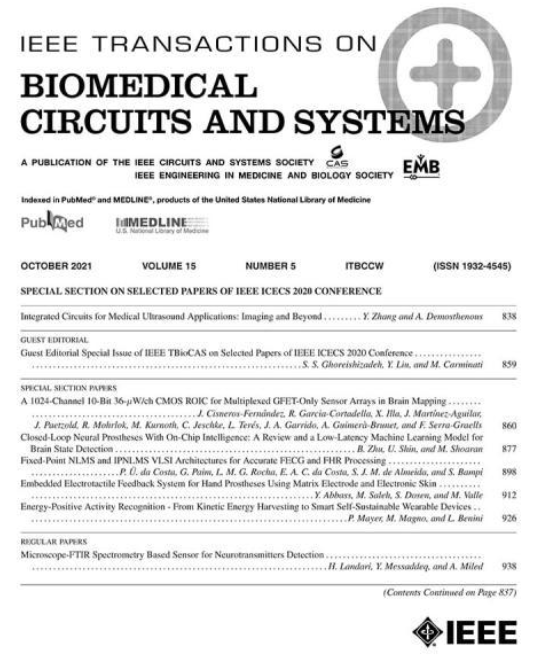A Robust System for Longitudinal Knee Joint Edema and Blood Flow Assessment Based on Vector Bioimpedance Measurements
IF 4.9
2区 医学
Q2 ENGINEERING, BIOMEDICAL
IEEE Transactions on Biomedical Circuits and Systems
Pub Date : 2016-06-01
DOI:10.1109/TBCAS.2015.2487300
引用次数: 37
Abstract
We present a robust vector bioimpedance measurement system for longitudinal knee joint health assessment, capable of acquiring high resolution static (slowly varying over the course of hours to days) and dynamic (rapidly varying on the order of milli-seconds) bioresistance and bioreactance signals. Occupying an area of 78×90 mm2 and consuming 0.25 W when supplied with ±5 V, the front-end achieves a dynamic range of 345 Ω and noise floor of 0.018 mΩrms (resistive) and 0.055 mΩrms (reactive) within a bandwidth of 0.1-20 Hz. A microcontroller allows real-time calibration to minimize errors due to environmental variability (e.g., temperature) that can be experienced outside of lab environments, and enables data storage on a micro secure digital card. The acquired signals are then processed using customized physiology-driven algorithms to extract musculoskeletal (edema) and cardiovascular (local blood volume pulse) features from the knee joint. In a feasibility study, we found statistically significant differences between the injured and contralateral static knee impedance measures for two subjects with recent unilateral knee injury compared to seven controls. Specifically, the impedance was lower for the injured knees, supporting the physiological expectations for increased edema and damaged cell membranes. In a second feasibility study, we demonstrate the sensitivity of the dynamic impedance measures with a cold-pressor test, with a 20 mΩ decrease in the pulsatile resistance associated with increased downstream peripheral vascular resistance. The proposed system will serve as a foundation for future efforts aimed at quantifying joint health status continuously during normal daily life.基于矢量生物阻抗测量的纵向膝关节水肿和血流评估稳健系统
我们提出了一种用于纵向膝关节健康评估的鲁棒矢量生物阻抗测量系统,能够获得高分辨率的静态(在数小时到数天内缓慢变化)和动态(在毫秒量级上快速变化)生物电阻和生物电抗信号。在±5 V供电时,前端的面积为78×90 mm2,功耗为0.25 W,在0.1-20 Hz的带宽范围内,动态范围为345 Ω,本底噪声为0.018 mΩrms(电阻)和0.055 mΩrms(无功)。微控制器允许实时校准,以最大限度地减少由于环境变化(例如,温度)可能在实验室环境之外经历的误差,并使数据存储在微型安全数字卡上。然后使用定制的生理驱动算法处理获取的信号,从膝关节提取肌肉骨骼(水肿)和心血管(局部血容量脉搏)特征。在一项可行性研究中,我们发现两名近期单侧膝关节损伤的受试者与七名对照组相比,受伤和对侧静态膝关节阻抗测量有统计学上的显著差异。具体来说,受伤膝盖的阻抗较低,这支持了生理上对水肿增加和细胞膜受损的预期。在第二项可行性研究中,我们通过冷压试验证明了动态阻抗测量的敏感性,随着下游外周血管阻力的增加,脉动阻力降低了20 mΩ。该系统将为未来在日常生活中持续量化关节健康状况的努力奠定基础。
本文章由计算机程序翻译,如有差异,请以英文原文为准。
求助全文
约1分钟内获得全文
求助全文
来源期刊

IEEE Transactions on Biomedical Circuits and Systems
工程技术-工程:电子与电气
CiteScore
10.00
自引率
13.70%
发文量
174
审稿时长
3 months
期刊介绍:
The IEEE Transactions on Biomedical Circuits and Systems addresses areas at the crossroads of Circuits and Systems and Life Sciences. The main emphasis is on microelectronic issues in a wide range of applications found in life sciences, physical sciences and engineering. The primary goal of the journal is to bridge the unique scientific and technical activities of the Circuits and Systems Society to a wide variety of related areas such as: • Bioelectronics • Implantable and wearable electronics like cochlear and retinal prosthesis, motor control, etc. • Biotechnology sensor circuits, integrated systems, and networks • Micropower imaging technology • BioMEMS • Lab-on-chip Bio-nanotechnology • Organic Semiconductors • Biomedical Engineering • Genomics and Proteomics • Neuromorphic Engineering • Smart sensors • Low power micro- and nanoelectronics • Mixed-mode system-on-chip • Wireless technology • Gene circuits and molecular circuits • System biology • Brain science and engineering: such as neuro-informatics, neural prosthesis, cognitive engineering, brain computer interface • Healthcare: information technology for biomedical, epidemiology, and other related life science applications. General, theoretical, and application-oriented papers in the abovementioned technical areas with a Circuits and Systems perspective are encouraged to publish in TBioCAS. Of special interest are biomedical-oriented papers with a Circuits and Systems angle.
 求助内容:
求助内容: 应助结果提醒方式:
应助结果提醒方式:


